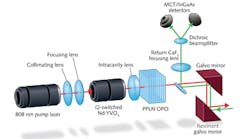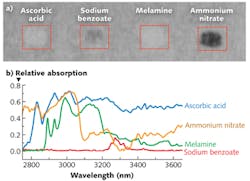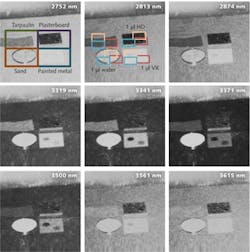SPECTRAL IMAGING: Active hyperspectral sensing and imaging for remote spectroscopy applications
NILS HEMPLER, JOHN NICHOLLS, and GRAEME MALCOLM
Advances in infrared (IR) lasers and detectors have been critically enabling for a wide range of sensing applications in different markets. Optical techniques offer the potential of contact-free detection, extremely high sensitivity, and the ability to detect a wide range of species. This is possible because every substance has a unique spectral signature associated with its specific molecules and bonding structure.
Hyperspectral imaging describes a remote sensing technology that allows the user to perform high-resolution spectroscopy on a scene from distance to identify and visualize the different substances present. However, in scenarios where the object of interest is at a significant distance from the observer (often tens of meters), high-resolution spectroscopy and sensing can be challenging. This is especially true when trying to detect minute quantities of complex gases, liquids, or solids in dynamic environments with confounding spectral backgrounds.
A number of high-impact applications would greatly benefit from technology that can address these challenges. For the oil and gas industry, remote standoff sensing and imaging would be a powerful tool for detecting miniscule leaks around wellheads, refineries, and storage facilities to ensure worker safety and to protect the environment. Equally important, standoff detection and imaging can be a critical tool in the defense and security sectors, where it has the potential to identify threat materials such as chemical warfare agents (CWAs) and explosives at safe distances.
When considering the technologies available to address these applications, limited options are available. The most commonly used solutions are based on Fourier transform infrared (FTIR) spectroscopy, Raman spectroscopy, or thermal imaging. Unfortunately, these technologies have limitations that make them less suitable for many of the emerging standoff detection markets.
FTIR has developed into a powerful hyperspectral imaging tool with high signal-to-noise ratios and spectral resolution. However, FTIR systems tend to be complex and require intensive data processing to gather the spectral information of the generated interference patterns, meaning real-time imaging is not practical. As a result, FTIR instruments developed for standoff detection tend to be large in size and prohibitively expensive for many applications.
Thermal imagers represent a more practical solution in specific standoff application scenarios, overcoming the limitations of FTIR in that they are lower in cost, operate in real time, are compact, and are easy-to-use devices. However, their reliance on passive illumination and detecting thermal changes limits absolute sensitivity and makes thermal imagers susceptible to fluctuations in ambient conditions (e.g., temperature, overcast/bright sunlight, and rain). In addition, thermal imagers offer limited wavelength selectability, meaning that they cannot differentiate between species or provide quantitative analysis of a target sample, which is critical for a threat detection solution.
Raman spectroscopy has a wide range of applications because of its ability to detect complex spectral signatures from solids and liquids. However, the Raman signal is very weak and is often masked by fluorescence from impurities or the sample itself. Furthermore, the laser sources used for illumination are typically not eye-safe, making Raman less suitable for remote detection in real-world scenarios, especially at range.
To overcome these limitations, M Squared Lasers has developed active hyperspectral imaging technology. This approach can offer broad continuous-wavelength selectability, quantitative analysis, immunity from external factors, and a compact footprint at relatively low cost.
Innovation for defense
M Squared Lasers was approached by the UK Defence Science and Technology Laboratory (Dstl), part of the UK Ministry of Defence, to help develop a solution that would satisfy the need for standoff remote detection and imaging in demanding military and civilian environments. The initial challenge was to detect and identify liquid deposits of CWAs on surfaces.
The first step was to design underpinning platform technologies that would be essential for reliable and practical solutions. To begin with, an alignment- and maintenance-free optomechanic mounting technology (called Invariant) was developed. In combination with a stainless-steel clamshell housing, this meant that the system could cope with extremely demanding environments.
Simultaneously, a series of compact, ultra-low-noise driver electronics (ICEBLOC) were designed, allowing control over Ethernet. ICEBLOC has the ability to cluster systems into sensor networks that can be controlled remotely, from a single point, anywhere in the world. Invariant and ICEBLOC have become the fundamental building blocks of all of M Squared's products.
Evolving the optical parametric oscillator
There were a number of key requirements for the light source: active illumination was seen as essential to detect small quantities with the required sensitivities at significant standoff distances; broad tunability was required for multispecies detection and differentiation; real-time imaging would enable fast acquisition of information; and a portable form factor enabled field deployment.
Limited options were available in the IR. The decision was between quantum cascade lasers (QCLs) and optical parametric oscillators (OPO). While the QCL offers a compact format, the limited tunability and relatively low output power at room temperature made them less attractive. OPOs combine high average and peak output power with much broader tunability but were typically more complex. However, the University of St. Andrews had developed a novel intracavity-pumped OPO (ICOPO).1 Crucially, the ICOPO places the nonlinear crystal into the pump resonator to gain access to the high intracavity field, thereby reducing the primary pump power consumption, component count, and footprint (see Fig. 1).
M Squared has evolved the ICOPO concept and engineered it into a new product: Firefly IR. Firefly can offer >500 mW of average output power with tuning between 1.4–4.5 μm, accessing absorption features of most species of interest. The high peak power of >300 W makes the system well suited to remote sensing applications.
Building on the novel source technology, an imager module was developed to transform the laser into an active hyperspectral imaging system. In this context, backscattered absorption spectroscopy provides spectral data of remote scenes. Short pulses from the ICOPO interact with the scene. At specific wavelengths, the target species absorbs light, modifying the back-reflected signal. Broad wavelength tuning in combination with two galvanometer mirrors allows scanning an area of interest, building up hyperspectral imaging cubes pixel by pixel.
Onboard data processing algorithms and drive electronics enable real-time, hyperspectral remote imaging of substances that have a spectral fingerprint within the broad emission band of the ICOPO. The small, self-contained form factor (shoebox size) and low power consumption mean that the imaging system is easily portable and can be operated from a battery power supply.
Standoff detection of threat materials
Initial trials of the technology have focused on the detection of threat agents at ranges considered safe for the user. A number of trials were conducted using materials in the powder and liquid phase separately to characterize the system's capabilities. In the first instance, M Squared investigated a combination of simulant, confusion, and energetic powders (for explosives).2
Trace quantities of ascorbic acid (C6H8O6), sodium benzoate (NaC6H5CO2), melamine (C3H6N6), and ammonium nitrate (NH4NO3) were deposited on a 1 cm2 block of cardboard and placed 1.5 m away from the system. Figure 2 shows the raw image recorded by the hyperspectral imager and spectral data for the four regions of interest.The results show the clear spectral features associated with the different materials. Comparing this data with reference data allowed clear identification of the materials, demonstrating the ability to distinguish between trace amounts of differentiation simulant, confusion, and energetic materials at range.
In the second set of experiments, performed in collaboration with Dstl and the U.S. Army Edgewood Chemical Biological Center, the imager was used to interrogate a number of CWAs.3 Here, tiny amounts (μl) of sulfur mustard (HD), VX, and water were deposited on painted metal, plaster board, tarpaulin, and sand and imaged using the imager. The results of the experiment can be seen in Fig. 3.This experiment and associated spectral analysis demonstrate that the system is capable of detecting and identifying minute quantities of HD and VX on a variety of surfaces at standoff ranges of multiple meters. This is a critical capability for remote detection of threat materials in a wide range of scenarios.
Oil and gas applications
For oil and gas applications, optical gas imaging solutions based on thermal imagers already exist (thousands of systems sold). However, users report frustration with detection limits and sensitivity to environmental variation. We compared the active, hyperspectral imager with a state-of-the-art thermal imager in a series of side-by-side experiments.
In the first experiment, a gas leak (pure butane/propane mix) was simulated. A thermal distortion in the form of escaping steam was placed into the scene to resemble a more realistic environment. The active, hyperspectral imager can clearly visualize the gas leak with excellent contrast while the thermal imager is dazzled by the thermal disturbance.
The next trial evaluated the lower detection limits. A gas leak was again simulated, this time consisting of approximately 5% methane (CH4). The result shown on the right hand side of Fig. 4 indicates that the thermal imager is unable to visualize the leak while the Firefly Imager clearly does. This has significant implications, especially for applications in the oil and gas industry, where 5% of methane represents the lower explosives limit.Technology roadmap
Active hyperspectral imaging has demonstrated compelling capabilities in remote sensing, standoff detection, and imaging applications in several markets. The technology can identify a wide range of substances in the gas, liquid, and solid phase. For modest standoff distances (tens of meters), the technology is more sensitive than state-of-the-art thermal imaging technology and is more practical than and cost-effective compared with stand-off FTIR systems and Raman-based systems.
The Firefly Imager was initially designed to be easily reconfigured to address multiple applications. Going forward, the system will be optimized for specific markets and key applications. Miniaturization of the system to a handheld device for oil and gas application is underway. New innovations of the ICOPO will see implementation of narrow-linewidth sources for increased spectral resolution as well as the development of long-wave IR (5–12 μm) sources to extend the system's capabilities in the critical spectral fingerprint region—this will enhance performance in specific defense and security applications.
Another key development will be implementation of heterodyne detection schemes to enhance range and sensitivity. With this approach, it has been possible to detect vapor from explosives to parts-per-million-meter levels at a >50 m range. Other applications are being explored, including mining, food and drink, forensics, and agriculture. However, this is just the start of an exciting journey toward practical implementation of active, hyperspectral imaging solutions that can transform how we remotely visualize and analyze complex scenes with hidden risks and opportunities.
REFERENCES
1. R. Conroy, C. Rae, M. Dunn, B. Sinclair, and J. Ley, Opt. Lett., 24, 1614–1616 (1999).
2. K. Ruxton, G. Robertson, B. Miller, G. P. A. Malcolm, and G. T. Maker, "Hazardous material analysis using mid-wave infrared hyperspectral imagining techniques," SPIE Defense, Security, and Sensing, Baltimore, MD (April 29–May 3, 2013).
3. C. R. Howle et al., "Mid-wave infrared hyperspectral imaging of unknown chemical warfare agents," SPIE Defense, Security, and Sensing, Baltimore, MD (April 29–May 3, 2013).
Nils Hempler is business development manager, John Nicholls is head of group, business development and strategy, and Graeme Malcolm is CEO at M Squared Lasers, 1 Kelvin Campus, West of Scotland Science Park, Maryhill Road, Glasgow, Scotland, G20 0SP, UK; [email protected]; www.m2lasers.com.



